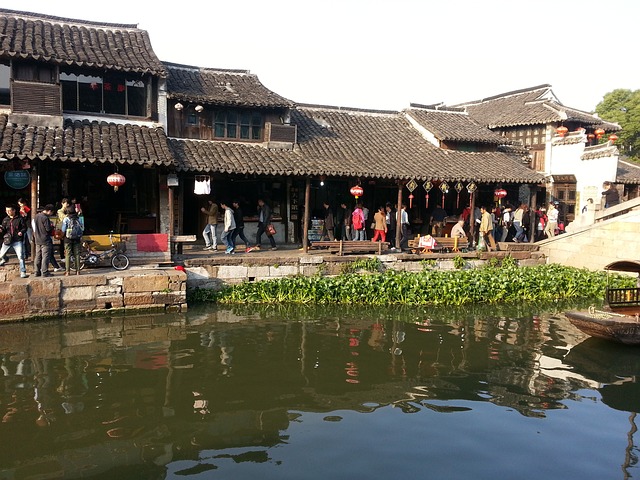
In the bustling urban village of Zengbu, located in the Guangdong province of southern China, a unique scenario unfolds amidst its aging population. Nestled alongside the Zengbu River, the village faces recurrent flooding during heavy rainstorms and typhoons, particularly in its lower-lying areas. Despite prompt evacuation advisories from local authorities during these perilous times, a segment of the elderly residents steadfastly refuses to relocate. Huang Yingxin, head of the environmental program at Harmony Community Foundation (HCF), sheds light on this curious phenomenon, revealing that in some instances, the authorities have resorted to cutting off power supplies in a bid to persuade them.
The question arises: why are these older residents so resistant to evacuation when faced with imminent danger?
In an endeavor to unravel this enigma, HCF volunteers and researchers embarked on a comprehensive survey spanning 29 communities across five cities in the Pearl River Delta, including Guangzhou, Shenzhen, and Foshan. Their exhaustive research, culminating in a study published in October 2023, seeks to elucidate how climate change risks are perceived, communicated, and mitigated at the grassroots level in southern China.
Among the communities scrutinized, Zengbu emerged as a focal point, having weathered nearly annual flooding until infrastructural upgrades were implemented in 2023. Over time, residents developed coping mechanisms, such as elevating valuables above ground level, fostering a sense of familiarity with flooding that, paradoxically, led some to underestimate its perils, according to Huang.
The findings of the HCF study reveal a profound awareness among southern Chinese communities regarding the ramifications of climate change. Direct encounters with natural disasters, health concerns, and disruptions to travel serve as poignant educators, eclipsing the influence of scientific data or governmental emissions reduction policies related to climate change.
While the central government has furnished policy directives for climate adaptation endeavors, including the "National Strategy for Climate Change Adaptation" in 2013 and the "Action Program for Urban Climate Change Adaptation" in 2016, along with selecting 28 municipalities for pilot projects aimed at fostering climate-resilient cities in 2017, the efficacy of adaptation efforts varies significantly from one community to another.
Achieving successful climate adaptation in urban areas necessitates a granular evaluation of climate resilience at the local community level. Recognizing the diverse capacities and challenges inherent in each neighborhood is paramount, as underscored by another report from HFC.
To forge resilient communities capable of navigating the multifaceted challenges posed by climate change, it is imperative to heed the voices and experiences of those on the frontline, fostering a collaborative approach that integrates local wisdom with scientific insights and policy initiatives.
A Holistic Approach to Climate Adaptation Assessment
In the face of escalating climate challenges, coastal cities like Guangzhou and Shenzhen are on the frontlines of combating rising sea levels and the looming threat of coastal flooding. Urgency permeates the air as communities strive to bolster their resilience against these environmental adversaries.
Assessing climate resilience at the community level is akin to solving a multifaceted puzzle with ever-shifting pieces. Despite the pressing need for comprehensive evaluations, a standardized methodology remains elusive, leaving researchers grappling with diverse approaches and indicators.
Zheng Yan's groundbreaking research, spanning from 2010 to 2016, dissected the climate resilience of 16 Beijing districts, proposing an array of 17 evaluation indicators. Yet, amidst the data, Zheng Yan astutely noted the inadequacy of existing statistical measures in encapsulating the entirety of climate resilience.
Zhu Anqi sheds light on the intricacies of obtaining granular data, especially at the community level, where the quest for information becomes even more labyrinthine. Here, qualitative insights gleaned from questionnaire-based surveys reign supreme, transcending the limitations of quantitative metrics to capture the essence of community perceptions and adaptation strategies.
Huang Yingxin champions the transformative potential of community engagement, advocating for the continuous refinement of assessment tools through local dialogues. By empowering residents to define resilience on their own terms and articulate their adaptation needs, a more holistic understanding of community dynamics emerges.
As Lynda Cheshire's 2015 study illuminates, the power of neighborly solidarity serves as an invaluable asset in navigating crises. However, Zhu Anqi underscores a critical oversight in current resilience assessments, highlighting the understated significance of close social networks in bolstering community resilience.
Recognizing the interconnectedness of social cohesion, emergency preparedness, and climate risks, Harmony Community Foundation (HCF) pioneers a comprehensive approach to resilience evaluation. By probing into emergency supplies, neighborhood connections, and insurance coverage, HCF's questionnaire delves beyond conventional metrics to unveil the multifaceted fabric of community resilience.
As climate adaptation assessments evolve, embracing diverse perspectives and community-driven methodologies becomes paramount. By bridging the gap between quantitative analysis and qualitative insights, researchers can unlock the intricate tapestry of community resilience, empowering cities to navigate the tumultuous seas of climate change with resilience and resolve.
Bridging Perception and Action in Climate Resilience
In the dynamic realm of climate change, understanding how urban communities perceive and respond to environmental hazards is pivotal for fostering resilience. A recent report examining the climate risk perceptions and resilience strategies of urban communities in the Pearl River Delta unveils insights into residents' perceptions, revealing both challenges and opportunities for climate adaptation.
Residents in the Pearl River Delta identify typhoons, storms, and heatwaves as the primary climate hazards, mirroring the region's increasing vulnerability to extreme weather events due to climate change. However, while immediate events garner attention, there's a gap in understanding long-term changes in average conditions and national climate targets.
The report exposes concerning gaps in community preparedness, with many households lacking insurance coverage and emergency supplies despite facing mounting climate risks. While emergency drills are common, tangible measures to enhance resilience, such as insurance uptake and emergency supply provision, are often overlooked.
Rather than grading resilience, the survey aims to empower communities by providing tailored insights to inform targeted interventions. Recommendations include bolstering disaster-relief messaging, promoting insurance uptake, and fostering community cohesion through voluntary services and support groups. By empowering communities to take ownership of their adaptive capabilities, resilience can be strengthened from within.
While caution is advised against directly extrapolating findings to other regions, the report marks a crucial step towards engaging urban communities in climate adaptation planning. It emphasizes the need for inclusive policies that address the diverse needs of rural and marginalized urban populations.
Infrastructure plays a critical role in climate resilience, yet grassroots perspectives are equally invaluable in shaping effective adaptation strategies. Residents stress the importance of well-maintained roads, efficient drainage systems, and reliable utilities in mitigating climate risks. Policymakers are urged to integrate local insights into infrastructure planning to enhance community resilience effectively.
In the pursuit of climate resilience, the study advocates for policymakers to prioritize vulnerable populations and address residents' needs and expectations. By promoting climate justice and fostering inclusive adaptation measures, communities can fortify their resilience against the impacts of climate change, ensuring a sustainable and equitable future for all.
